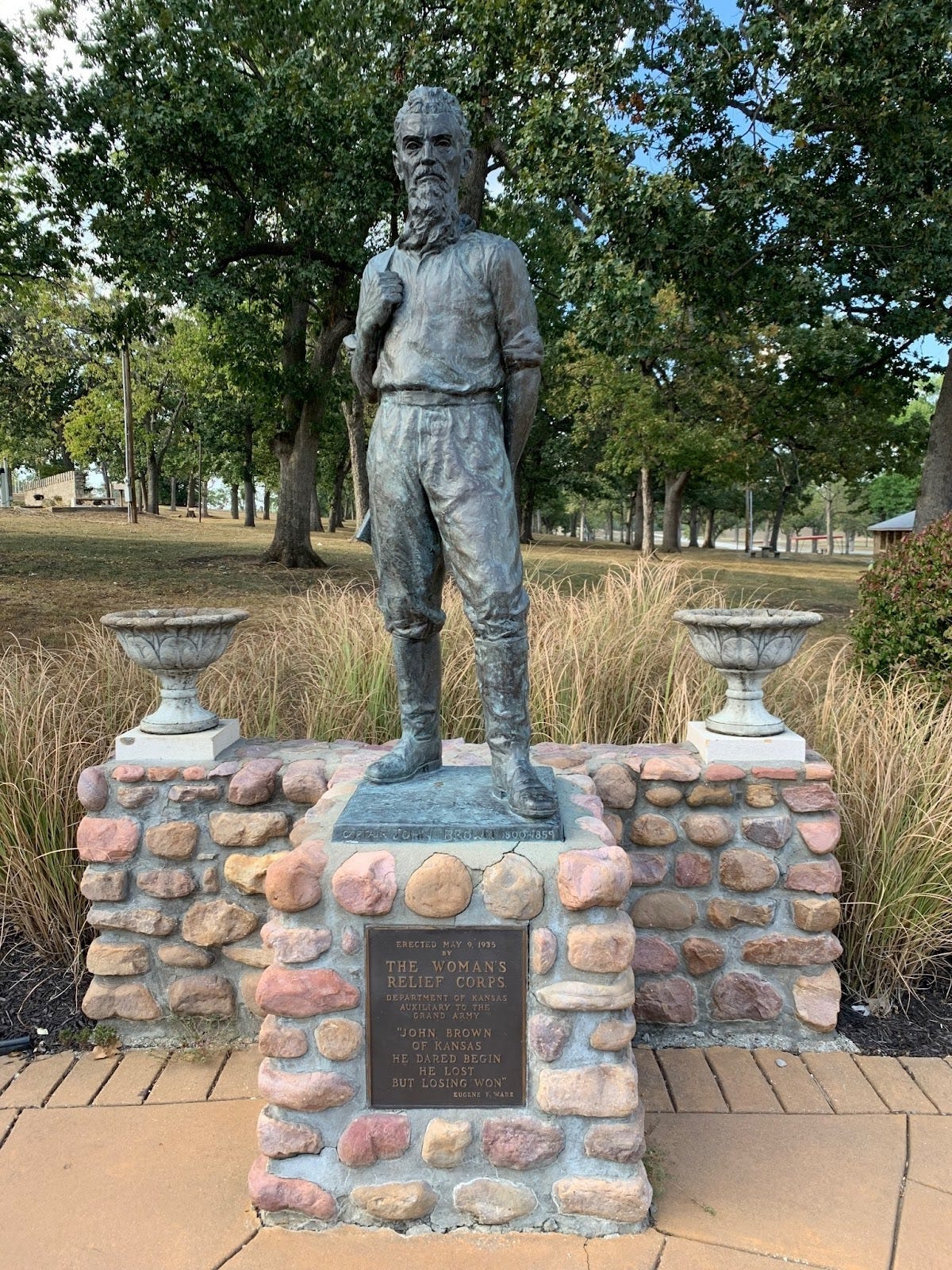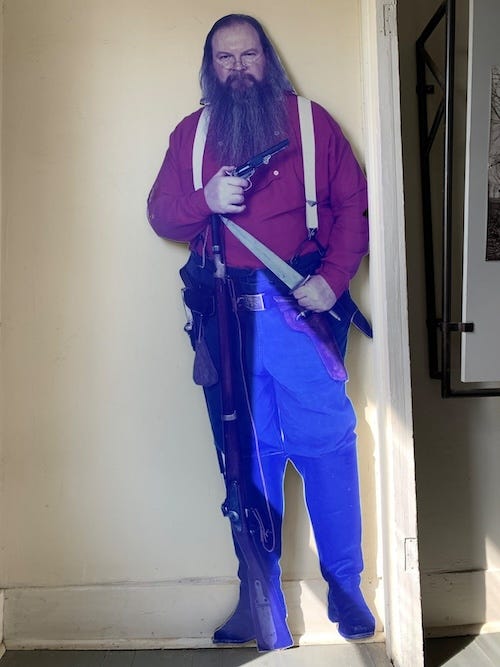[Editor’s Note: Over the course of 2022 and 2023, New American History Executive Director Ed Ayers is visiting places where significant history happened, and exploring what has happened to that history since. He is focusing on the decades between 1800 and 1860, filing dispatches about the stories being told at sites both famous and forgotten. This is the 22nd installment in the series.]
When did the American Civil War begin? Americans have argued about that since the Civil War itself. Some see the seeds of the conflict baked into the Constitution, which sidestepped the issue of slavery and left the relationship between the states and the federal government ambiguous enough to permit decades of disunion talk. Others point to the 1793 invention of the cotton gin, a machine that gave slavery new economic life in the vast territories of the southeast. There are those who see the Missouri Compromise of 1820 as laying the groundwork for an unavoidable conflict, while others date the crisis to the emergence of “immediate abolitionism” in the early 1830s, the conflagration of the war with Mexico in the 1840s, the Compromise of 1850, or the Kansas-Nebraska Act of 1854. Some place the Dred Scott decision of 1857 in a central role, followed by the Lincoln-Douglas debates of 1858.
Some argue that it was not until the splintering of the Democratic Party at its convention in 1860 that the Electoral College door was opened to a Republican candidate, who turned out to be Abraham Lincoln. When Lincoln was elected with less than 40 percent of the popular vote, the slave states began to secede, and the Confederacy emerged. Much remained unsettled through 1860 and 1861, but also for the duration of the war. While I have argued elsewhere against rushing the story along, and against telescoping events separated by years into a certain outcome, it is true that the conflict over slavery was deep and ultimately unavoidable.
One thing each interpretation agrees upon is that the violence, chaos, and bitterness that inflamed Kansas in the late 1850s escalated the conflict between free states and slave states to new levels of virulence and bloodshed. The fights in Kansas, as the territory struggled to become a state, ignited all the elements of the long-simmering American conflict: slavery, religion, abolitionism, federal policy, and local politics. It revealed the vulnerability of the American political system to fraud and intimidation. It dragged easterners into fights over western territories. It unleashed the volatile power of the new telegraph system to turn local conflict into national controversy. And it introduced John Brown as a new kind of hero and villain.
The outlines of the fight in Kansas appear in every textbook. “Bleeding Kansas” has become one of the main stations on the railroad to Civil War. The town of Lecompton figures centrally in that story, and I was eager to see this place for myself.
But first, we visited the town of Osawatomie, where John Brown Memorial Park commemorates the abolitionist’s emergence on the national stage. The centerpiece of the park is a log cabin encased in a protective masonry building, reminding us of the grand Lincoln Birthplace Memorial we had visited in Kentucky. The Kansas memorial, built in 1928, features the Adair Cabin, the residence of John Brown’s half-sister Florella, her husband Samuel, and their two children. It was there that Brown and five of his sons settled during their Kansas campaign. The cabin was dismantled and reconstructed in the park, which occupies the Battle of Osawatomie site.
Signs tell the story: “On the morning of August 30, 1856, John Brown led about 30 antislavery men into battle against 250 pro-slavery Missourians.” Brown positioned his men in timber along a nearby river and resisted the first attacks, but the Missouri forces had a cannon and drove the antislavery men across the river. Another sign tells visitors that “the Missourians swarmed into Osawatomie, where they sacked and burned the town. Both sides sustained about half a dozen casualties, the most of any battle during the Bleeding Kansas period. Among the dead was John Brown’s son Frederick.” Throughout the park, among play equipment and picnic tables, key points in the Battle of Osawatomie are identified with markers and detailed explanations. One plaque conveys a quote attributed to Brown by his son Jason “as they watched Osawatomie burn”:
God sees it. I have only a short time to live — only one death to die and I will die fighting for this cause. There will be no more peace in this land until slavery is done for.

It would take three more years before Brown’s prophecy of his own martyrdom came to pass, but here, his final campaign in Harpers Ferry and his fight in Osawatomie are fused into one. A striking brass statue of Brown, cast by “the same foundry in Paris which made the Statue of Liberty,” a sign proudly announces, was erected in 1935 by the Women’s Auxiliary of the Grand Army of the Republic. It declares that John Brown of Kansas “dared begin. He lost but losing won.”
The Osawatomie park, memorial, and statue speak of the 1930s as well as of the struggles of the 1850s. They declared the battle in Kansas to be the beginning of the redemptive war that brought slavery to an end in the United States. It is hard to blame them. Even if American history between 1856 and 1860, and between 1863 and 1865, could have, and nearly did, pivot in other directions, it did not. A memorial is meant to simplify history and this one does so in an evocative and enduring way.
Nearby Lecompton has a more complicated story to tell than Osawatomie.
The day Abby and I visited, a television reporter from Kansas City was interviewing historical interpreters in costume. They were promoting the town’s various attractions, most of them connected in one way or another to the moment in the 1850s when news of Lecompton filled the nation’s newspapers and inspired fights in Congress. A sign in front of the city’s museum summarized the significance of Lecompton, simplifying a complex story much as the John Brown Memorial in Osawatomie did. In Lecompton, people would find the “Civil War Birthplace” and “Where Slavery Began to Die.” Abraham Lincoln’s face appeared between the two slogans.
Another sign, bearing the same slogans, narrated the outlines of the story efficiently and effectively:
In 1855 the new town of Lecompton became the capital of Kansas Territory. President James Buchanan appointed a governor and officials to establish government offices in Lecompton, and construction began on an elegant capitol building. In the fall of 1857, a convention met in Constitution Hall and drafted the famous Lecompton Constitution, which would have admitted Kansas as a slave state.

A local history museum presents documents and images from the years of Bleeding Kansas, interspersed with artifacts from the rest of the town’s history — including the wedding of Dwight Eisenhower’s parents in the 1880s. More powerful, though, is Constitution Hall, where the 1857 drama is well represented. The building saw settlers rush in to claim lands in the territory, sometimes fighting with one another over disputed boundaries. Upstairs, pro-slavery legislators drafted a constitution that protected slavery; anti-slavery legislators refused to participate. The next year, anti-slavery legislators won in local elections and came to the same room to draft a new constitution. The anti-slavery legislators also moved their meetings from the “pro-slavery capital of Lecompton to the free-state town of Lawrence,” an exhibit outside the building explains. Lecompton lost its position as capital.
Inside, exhibits confront the history of Lecompton and Bleeding Kansas without glorification. “Many young, unattached men came seeking their fortunes. They had no families to temper their wild ways. Many of them drank to excess. Some, young and old, were criminals who had left their former homes one step ahead of the law. The lax law enforcement in Kansas Territory allowed them to easily find new victims.”
A cabinet displaying guns and swords portrays John Brown in a different light than in Osawatomie: “The militants such as John Brown and his sons used artillery swords when they murdered five of their proslavery neighbors on Pottawatomie Creek in 1856.” At the top of a staircase, we were startled by imposing life-size cutouts of some of the men who rushed to Kansas in the 1850s.

The exhibits detail how Kansans defeated the Lecompton Constitution in August 1858 by a five-to-one margin and celebrated the victory as a victory for freedom. As one man wrote in his diary, the overturning of the constitution written in that building meant that “the whole land is filled with rejoicing.”
The exhibits at Lecompton, then, a town saddled by its association with the disgraced pro-slavery movement, convey its connection in a straightforward way. Perhaps some of the people watching the Kansas City television news that evening, intrigued by the brief appearance of the costumed interpreter, came to Lecompton to see where the Civil War “began,” even if other places across the nation could make the same claim.
